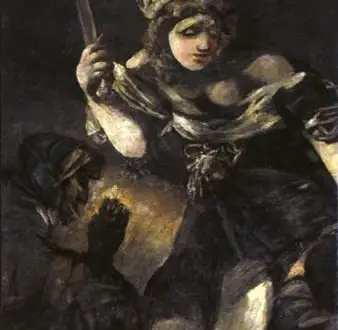Title of Artwork: “Judith and Holofernes”

Artwork by Francisco Goya
Year Created 1820-1823
Summary of Judith and Holofernes
A painting by Francisco de Goya called “Judith and Holofernes” is one of the 14 “Black Paintings” he made between 1819 and 1823, when he did them. By this point, Goya was in his late 70s and had lost faith in everything. In 1819, he bought the Quinta del Sordo (The House of the Deaf Man), which he used to paint his private works on the walls of his home. He used oils to paint right on the plaster, which made it look like a real house.
All About Judith and Holofernes
Judith and Holofernes is probably on the first floor, next to Saturn Destroying His Son. When Judith, the main character, saves Israel by seducing and beheading a general named Holofernes, the picture is based on her own interpretation of the story of the Book of Judith. In the Black Paintings, Judith is the only person from history who can be found with 100% certainty.
This is the colour palette of Judith and Holofernes: blacks, ochres, and reds are painted with very wide and energetic brush strokes. It looks like a night scene lit by a torch, which illuminates Judith’s face and outstretched arm, but leaves the face of the old servant in the dark. When you look at most art, you usually don’t see Holofernes or the blood that comes from his neck. This is unusual, though.
Because of Goya’s bitter disappointment with Fernando VII’s second restoration, it’s possible that Holofernes is the Spanish King, whom Goya was personally angry with. As a symbol of the end of tyranny, many artists used the death of Holofernes to show that it was possible to defeat it.
This would have been brave and daring for an artist with strong ties to the crown like Goya. Goya, on the other hand, didn’t think that anyone else would ever see the series, which gave him more freedom to express himself in the work. If you don’t like his political views, you can’t see them. His The Disasters of War series, for example, was only published 35 years after he died because he kept it a secret.
There are a lot of different ways to look at it. Leocadia, the young maid and companion he had in his last years, may be a theme in this work. It’s more likely that the picture is about the strength of women over men in general. If you look at the painting from a psychological point of view, you can see that it talks about castration.
This is because Goya was an old man who had been married for more than 70 years, and he lived with a much younger lover. The painting may be important because it used to be next to one that was thought to show Leocadia near Goya’s grave.
A curator at the Museo del Prado helped Baron Emile d’Erlanger move the painting to canvas in 1873–74. Salvador Martnez Cubells, who was in charge of the painting, helped. It was in 1881 that D’Erlanger gave all 14 of his paintings to the Prado.
Information Citations
En.wikipedia.org, https://en.wikipedia.org/.























